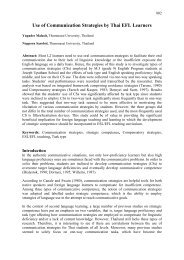The Effects of Semantic Mapping on Vocabulary Memorizing
The Effects of Semantic Mapping on Vocabulary Memorizing
The Effects of Semantic Mapping on Vocabulary Memorizing
You also want an ePaper? Increase the reach of your titles
YUMPU automatically turns print PDFs into web optimized ePapers that Google loves.
Firstly, the students’ attitudes towards the semantic mapping technique at the two points <str<strong>on</strong>g>of</str<strong>on</strong>g><br />
measurement (before and after the study) were analyzed with the Descriptive Statistics Test.<br />
Table 9 below displays the results <str<strong>on</strong>g>of</str<strong>on</strong>g> the test.<br />
Table 9. Descriptive Statistics <str<strong>on</strong>g>of</str<strong>on</strong>g> the Students’ Attitudes towards <str<strong>on</strong>g>Semantic</str<strong>on</strong>g><br />
<str<strong>on</strong>g>Mapping</str<strong>on</strong>g> at the Two Points <str<strong>on</strong>g>of</str<strong>on</strong>g> Measurement<br />
Points <str<strong>on</strong>g>of</str<strong>on</strong>g> measurement N Min Max Mean(M) SD<br />
Before the experiment 30 2.73 4.36 3.43 .342<br />
After the experiment 30 3.00 4.27 3.69 .347<br />
It can be seen from Table 9 that the questi<strong>on</strong>naire mean score <str<strong>on</strong>g>of</str<strong>on</strong>g> the experimental group after the<br />
experiment (M = 3.69) is higher than that <str<strong>on</strong>g>of</str<strong>on</strong>g> the same group before the experiment (M = 3.43).<br />
2.2 Comparis<strong>on</strong> <str<strong>on</strong>g>of</str<strong>on</strong>g> the students’ attitudes towards semantic mapping within the experimental<br />
group before and after the study<br />
<str<strong>on</strong>g>The</str<strong>on</strong>g> Paired Samples T-Test was c<strong>on</strong>ducted to compare the mean difference in the students’<br />
attitudes towards semantic mapping before and after the study. <str<strong>on</strong>g>The</str<strong>on</strong>g> results are reported in Table<br />
10.<br />
Table 10. Paired Samples T-Test <str<strong>on</strong>g>of</str<strong>on</strong>g> the Students’ Attitudes towards <str<strong>on</strong>g>Semantic</str<strong>on</strong>g><br />
<str<strong>on</strong>g>Mapping</str<strong>on</strong>g> at the Two Points <str<strong>on</strong>g>of</str<strong>on</strong>g> Measurement within the Experimental<br />
Group<br />
Paired Samples Test<br />
Pair 1 MEANPRE -<br />
MEANPOST<br />
Mean<br />
Std.<br />
Deviati<strong>on</strong><br />
Paired Differences t df<br />
Std.<br />
Error<br />
Mean<br />
95%<br />
C<strong>on</strong>fidence<br />
Interval <str<strong>on</strong>g>of</str<strong>on</strong>g> the<br />
Difference<br />
Lower Upper<br />
Sig. (2tailed)<br />
-.2621 .38913 .07105 -.4074 -.1168 -3.690 29 .001<br />
As shown in Table 10, the mean difference (MD = -.26) in the students’ attitudes towards<br />
semantic mapping before and after the study was statistically different (t = -3.69, df = 29, p =<br />
.001). <str<strong>on</strong>g>The</str<strong>on</strong>g> result indicated that the level <str<strong>on</strong>g>of</str<strong>on</strong>g> the students’ attitudes towards semantic mapping<br />
before and after the study was statistically different; the post level (after the study) was<br />
significantly higher than the initial level (more the study). We could c<strong>on</strong>clude that the students in<br />
the experimental c<strong>on</strong>diti<strong>on</strong> adopted more positive attitudes towards semantic mapping after the<br />
study.<br />
3. Students’ attitudes towards semantic mapping (from the findings <str<strong>on</strong>g>of</str<strong>on</strong>g> the interview)<br />
After the study, besides the quantitative data analysis, some interviews were carried out to<br />
provide deeper insight into what the students thought about the use <str<strong>on</strong>g>of</str<strong>on</strong>g> semantic mapping. In<br />
additi<strong>on</strong>, the researcher could identify and understand why the students came up to the results in<br />
649






